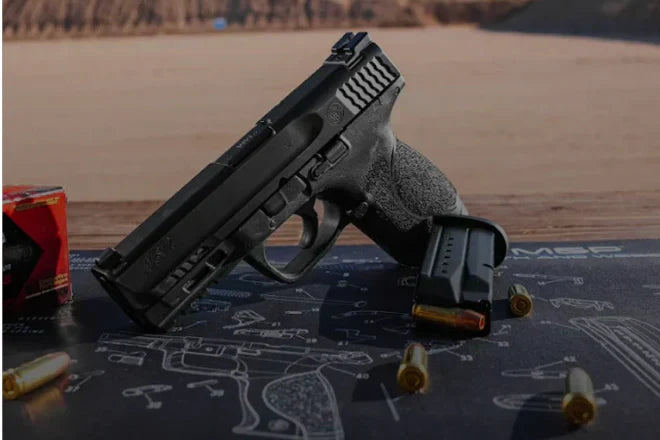A gun cleaning mat may seem like a small accessory, but its material can make a big difference in how efficiently you maintain your firearm. From resisting harsh solvents to protecting delicate finishes, the surface under your gun plays a critical role in the cleaning process. Choosing wisely isn’t just about comfort; it’s about preserving your firearm, keeping your workspace safe, and ensuring every cleaning session runs smoothly.
Understanding the Role of Mat Material in Gun Care
Gun cleaning mats protect your bench, keep parts organized, and shield your firearm from unnecessary wear. But the benefits depend heavily on what the mat is made of. Material choice significantly impacts how well the mat handles oils, its stability during cleaning, and the level of protection it offers against scratches or corrosion over time.
Why Material Choice Matters for Firearm Longevity
A mat with the right properties creates a safe, stable environment for cleaning. Soft materials protect delicate finishes from micro-scratches, while non-porous surfaces prevent harmful solvents from soaking through. This can be the difference between a firearm that looks factory-fresh years later and one that shows premature wear.
How Mat Materials Interact with Solvents, Oils, and Debris
Solvents and gun oils can react differently depending on the material.
-
Neoprene resists most common cleaning chemicals but may retain oily residue if not cleaned promptly.
-
Rubber provides excellent chemical resistance and doesn’t absorb oil, making cleanup quick and easy.
-
PVC is almost impervious to solvents and won’t stain easily, even with aggressive cleaners.
-
Felt and fabric blends absorb oils quickly, which can lead to staining, odor retention, and reduced grip over time.
-
Microfiber soaks up oils effectively, which is great for quick cleanups but can shorten the mat’s lifespan if not washed regularly.
Textured surfaces in some mats can trap debris and small parts, while smoother ones allow fast wipe-downs; choosing between them depends on whether you prioritize part control or easy cleaning.
Common Gun Cleaning Mat Materials Explained
Neoprene
A dense, flexible synthetic rubber with a fabric top. Neoprene mats are popular for their balance between cushioning, chemical resistance, and portability. They roll up easily for storage or transport, making them a favorite for range bags.
Rubber
Heavy-duty and naturally grippy, rubber mats stay anchored during cleaning, even with vigorous scrubbing. Their dense structure resists cuts and gouges, making them ideal for frequent use in fixed setups.
PVC
A rigid, solvent-proof plastic that handles aggressive cleaners without warping or staining. PVC mats are easy to wipe down and extremely durable, but can feel less comfortable in the hands during extended cleaning sessions.
Felt/Fabric Blends
Soft and quiet, these mats are gentle on high-polish finishes and blued steel. However, their absorbent nature means they require more care to prevent oil buildup and staining.
Microfiber
Lightweight and extremely absorbent, microfiber mats excel at quick maintenance work. They pull oils and moisture away from firearm surfaces, but aren’t ideal for prolonged exposure to strong solvents.
How Each Material Impacts Cleaning and Maintenance
The choice of material directly affects how easy or difficult it is to keep your workspace clean, how stable your firearm feels during maintenance, and how well the mat stands up to repeated chemical exposure.

Neoprene
-
Pros: Excellent chemical resistance, cushioned surface, easy to roll up.
-
Cons: Can retain odor if not cleaned regularly.
Rubber
-
Pros: Extremely durable, non-slip grip, solvent-resistant.
-
Cons: Bulkier and less portable.
PVC
-
Pros: Highly resistant to oils and solvents, wipes clean easily.
-
Cons: Can feel stiff in colder environments.
Felt/Fabric Blends
-
Pros: Very gentle on finishes, quiet work surface.
-
Cons: Absorbs liquids, harder to clean.
Microfiber
-
Pros: Ultra-lightweight, great for absorbing excess oil.
-
Cons: Not ideal for heavy-duty cleaning sessions.
Comparison Table: Gun Cleaning Mat Materials

Why Cerus Gear Stands Out
While many gun cleaning mats offer basic protection, Cerus Gear takes it further with premium construction designed for serious shooters:

-
Base: Made from 1/8" (3 mm) vulcanized rubber with a non-slip texture for rock-solid stability on your bench.
-
Top Layer: Heat-bonded polyester surface for a comfortable workspace and protection against scratches.
-
Graphics: Dye sublimation printing ensures diagrams and designs never fade or wear off, even with heavy use.
-
Chemical Resistance: Built to withstand oils and solvents commonly used in firearm maintenance without degrading.
-
Additional Note: Some models also feature a neoprene base with a nylon top, adding extra durability and grip.
This combination not only protects your firearm and workspace but also delivers a long-lasting tool you’ll rely on for years.
Matching Material to Your Gun Care Routine
Rather than chasing a single “best” material, think about how you use your mat:
-
Frequent deep cleaning: PVC or rubber for chemical resistance and durability.
-
Quick wipe-downs: Microfiber or felt for gentle handling.
-
Portable setups: Neoprene for flexibility and easy storage.
-
Detailed maintenance: Printed mats (any material) for keeping parts organized.
Care and Maintenance Tips by Material Type
Neoprene
Wipe with a damp cloth and mild soap after each session. Avoid strong solvent contact with the fabric top. Air dry fully before rolling to prevent mildew.
Rubber
Rinse under warm water or wipe with a degreaser-safe cloth. Store flat to avoid warping, and keep out of prolonged direct sunlight to prevent surface hardening.
PVC
Clean with a soft cloth and a solvent-safe cleaner. For stubborn stains, a light scrub with a nylon brush works well. Store flat or loosely rolled.
Felt/Fabric Blends
Spot clean with mild detergent and water. For deeper cleaning, use a gentle upholstery cleaner. Avoid soaking, as this can weaken the material.
Microfiber
Machine wash on cold without fabric softener, as it can reduce absorbency. Air dry to maintain softness and structure.
Conclusion
Material choice isn’t just a technical detail; it’s a performance factor. Whether you prefer the rugged grip of rubber, the flexibility of neoprene, or the gentle touch of felt, matching the right mat to your cleaning style can make every maintenance session more efficient. Cerus Gear’s mats go beyond the basics, combining stable grip, chemical resistance, and fade-proof graphics for a workspace upgrade that lasts as long as your firearm.
FAQ
Can you wash a neoprene gun cleaning mat?
Yes, use mild soap and water, then air dry completely before rolling or storing.
What’s the most durable material for a gun cleaning mat?
Rubber and PVC are generally the most durable and solvent-resistant options.
Do rubber mats absorb gun oil?
No, rubber is non-porous and won’t absorb oils, making it easy to clean.
Which material is easiest to clean after using solvents?
PVC and neoprene are among the easiest to wipe clean after heavy solvent use.
Are printed mats less durable than plain ones?
Not necessarily, durability depends on the base material and print quality, not just the design.






